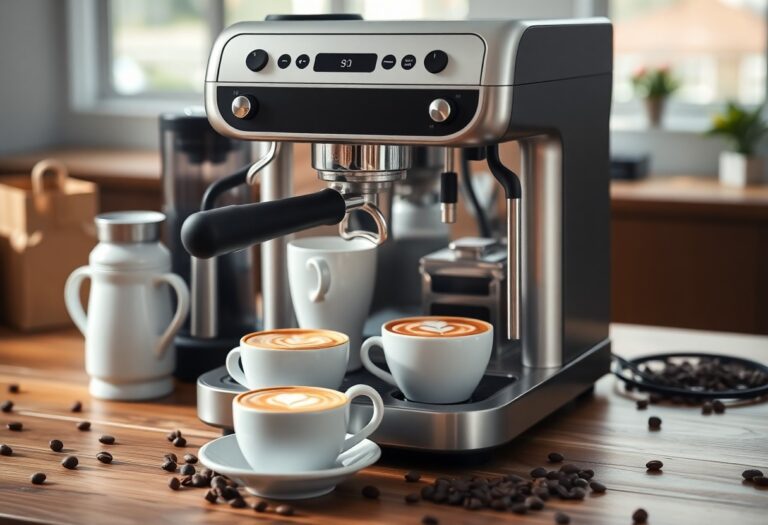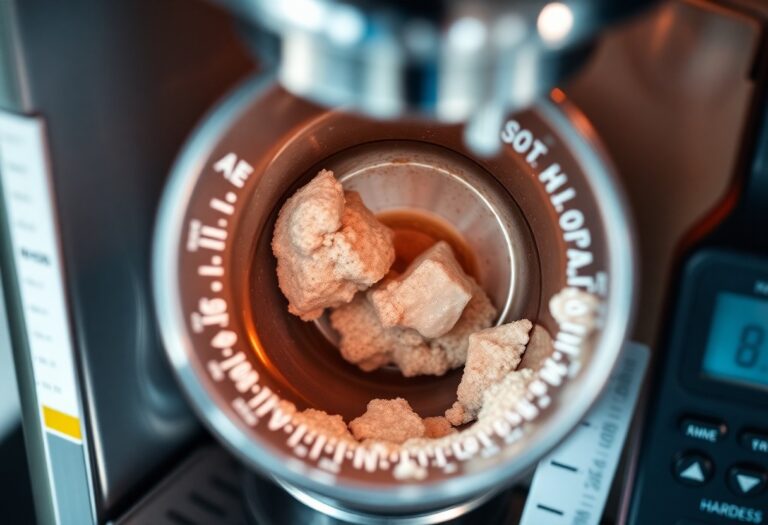How to Clean a Drip Coffee Machine: Maintenance Instructions
Knowing how to clean a drip coffee machine is important for anyone who loves fresh, delicious coffee. This article provides simple maintenance instructions to keep your drip coffee maker working perfectly. Cleaning a drip coffee machine involves more than just rinsing it; there are specific routines you need to follow to prevent buildup, protect the inner parts, and improve the taste of every cup.
Here are the main reasons why cleaning your drip coffee machine regularly is beneficial:
- It gets rid of oils, residue, and mineral deposits that can affect how well your machine works.
- It helps your coffee maker last longer.
- It ensures that every cup of coffee tastes as good as possible.
By following these maintenance instructions, you’re not only improving the quality of your daily coffee but also taking care of your equipment so it will last longer. This guide breaks down practical steps you can take to easily maintain your drip coffee machine.
If you have other types of coffee machines, we also have detailed guides on how to clean a K-Cup coffee machine, how to use a Keurig coffee machine, and how to clean a Keurig coffee machine. For Mr. Coffee or Cuisinart machines, we have specific maintenance guides: how to clean a Mr. Coffee machine and how to clean a Cuisinart coffee machine.
1. Daily Cleaning Routine
Maintaining a consistent daily cleaning routine is key to keeping your drip coffee machine in top shape. After each use, start by unplugging the coffee maker. This simple step ensures safety while you clean and prevents any accidental electrical issues.
Next, focus on the removable parts: the carafe, carafe lid, and filter basket. These components directly contact your coffee and are prone to accumulating oils, stains, and leftover grounds that can affect taste. Use warm, soapy water to thoroughly wash each part. A mild dish soap works well to break down residues without damaging the surfaces.
Pay special attention to crevices or edges where coffee oils tend to build up over time. Avoid harsh scrubbing tools; instead, a soft sponge or cloth will do the job effectively without scratching your equipment.
After washing, make sure to rinse all parts thoroughly under clean running water. Soap residue left behind can alter flavor and cause an unpleasant aftertaste in your next brew.
Drying each piece completely is crucial before putting everything back together. Moisture trapped inside can promote mold growth or mildew, undermining both hygiene and flavor quality. Use a clean towel or air-dry the parts in a well-ventilated area.
Reassemble the machine only when all components are dry and spotless. This daily cleaning process not only safeguards your health but also preserves the integrity of your coffee’s flavor profile with every cup you brew.
For specific instructions on how to properly use and maintain different types of coffee machines, such as Cuisinart, Mr. Coffee, or filter coffee machines, you may find these basic operation instructions and brewing instructions helpful.
2. Descaling Your Drip Coffee Machine
Descaling is an essential part of taking care of your drip coffee machine. Over time, mineral buildup from hard water collects inside the internal parts, which can affect how well it works and make your coffee taste bad. If you skip descaling, you might have slower brewing times, uneven heating, and a bitter taste in your cup.
Why Descale?
- Performance Issues: Mineral buildup can lead to slower brewing times and uneven heating.
- Taste Problems: A bitter taste in your coffee can be a sign of scale buildup affecting the brewing process.
- Longevity of the Machine: Regular descaling helps prolong the lifespan of your coffee machine.
The Power of Vinegar
To solve this problem, a simple vinegar solution can work wonders. You can find out more about the right amounts of vinegar to use for cleaning your coffee machine, but generally, mixing equal parts white vinegar and water creates an effective descaling agent. White vinegar is acidic enough to dissolve mineral deposits but gentle enough not to damage your machine when used correctly.
Steps for Descaling Your Drip Coffee Machine
Here are the steps for the descaling process:
- Fill the water reservoir with the vinegar and water mixture.
- Run a brew cycle halfway, then pause the machine. Let it sit for 15 to 30 minutes. This resting period allows the vinegar solution to break down stubborn mineral buildup.
- Complete the brew cycle after the waiting time.
- Empty out the vinegar solution from the carafe.
- Run 2 to 3 full cycles with clean water only to rinse out any remaining vinegar residue.
This process flushes out scale deposits that accumulate around heating elements and water lines, restoring proper function and ensuring your coffee tastes fresh and clean every time you brew.
Frequency of Descaling
Regular descaling—about once a month or more frequently if you have hard water—prolongs your machine’s lifespan and keeps each cup tasting as intended by the roaster. It’s advisable to follow a complete decalcification guide for thorough results.
In addition to regular descaling, consider implementing some simple solutions for hard water in your home. Neglecting this step often leads to costly repairs or replacement down the line, so incorporate it into your maintenance schedule without fail. For those with a Keurig coffee machine, there are specific methods for descaling it effectively as detailed in this step-by-step guide.
3. Deep Cleaning for Optimal Performance
Deep cleaning your drip coffee machine is essential to maintain its optimal performance and extend its lifespan. Here are some key steps to ensure a thorough deep cleaning routine:
- Occasional Deep Cleaning: While daily cleaning focuses on regular maintenance, deep cleaning targets hard-to-reach areas that accumulate grime over time. It’s recommended to perform deep cleaning sessions periodically, similar to the comprehensive guide on how to clean a drip coffee machine, to keep your machine in top condition.
- Cleaning the Warming Plate: The warming plate of your coffee maker can collect coffee stains and spills, affecting both its appearance and functionality. Use a damp cloth with mild soap to gently wipe down the warming plate, removing any residue without damaging the surface.
- Wiping Exterior Surfaces: Dust, spills, and fingerprints can accumulate on the exterior surfaces of your coffee machine. To maintain a clean and polished look, regularly wipe down these areas with a damp cloth. Avoid using abrasive cleaners or rough scouring pads as they can scratch the finish.
By incorporating deep cleaning into your maintenance routine, you can ensure that every part of your drip coffee machine is clean and functioning optimally. Remember, a well-maintained coffee maker not only brews better-tasting coffee but also enhances the overall brewing experience for you and your guests.
For specific instructions tailored for different models such as Bunn coffee machines, refer to this resource on cleaning Bunn coffee machines. Additionally, if you’re looking for more general tips on maintaining and cleaning coffee makers, sites like Simple Green and HowStuffWorks offer valuable insights into effective cleaning methods for various types of coffee machines.
4. Additional Tips for Long-Lasting Freshness
Maintaining your drip coffee machine goes beyond daily cleaning and descaling. Paying attention to specific details can significantly extend the life of your machine and keep your coffee tasting fresh.
1. Consult Manufacturer Instructions
Every coffee maker model, such as the Keurig, or a Ninja, has unique features and care requirements. Checking the manufacturer instructions ensures you follow recommended cleaning methods and avoid damaging sensitive parts. Some machines may require specific cleaning agents or suggest different intervals for maintenance tasks.
2. Utilize Automatic Cleaning Functions
Modern drip coffee machines often include automatic cleaning functions. These built-in cycles are designed to simplify maintenance by running a self-cleaning process using water or special cleaning solutions. Activating these functions regularly keeps internal components free from buildup without requiring manual intervention, saving you time and effort.
3. Prevent Mold Growth
Moist environments inside coffee machines create ideal conditions for mold development, which affects both taste and safety. Consistent cleaning prevents mold formation by removing residual moisture and coffee oils where mold can thrive. Pay special attention to areas like the water reservoir, carafe lid, and filter basket, which easily trap moisture.
Adopting these additional tips complements your regular cleaning routine. By following manufacturer guidance, taking advantage of automatic functions, and focusing on mold prevention, you create an environment that produces better-tasting coffee while protecting your investment from premature wear or contamination. If you’re unsure about how to clean your machine properly, refer to this essential maintenance guide. Alternatively, if you’re exploring different brewing methods, you might find this French press guide helpful.
For those considering a shift towards more advanced coffee makers like superautomatic machines, it’s worth noting that brands like Jura have garnered positive feedback within the community, as discussed in this Reddit thread.
Lastly, if you’re a beginner looking for a simple coffee machine usage guide, we have that covered too!
Conclusion
Consistent cleaning and maintenance are vital for a well-functioning drip coffee machine. For those who own a Krups or a Ninja coffee machine, following specific maintenance guides can significantly enhance their lifespan and performance.
Implement these simple steps into your routine for enjoying delicious hassle-free coffee daily. And remember, if your machine is on the fritz, don’t hesitate to explore manual brewing methods or learn how to make espresso without an espresso machine by checking out our guide on making espresso without a machine. Alternatively, you could also delve into the intricacies of brewing coffee with an espresso machine for a different flavor experience.







